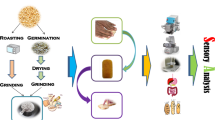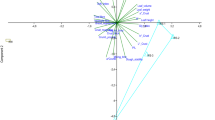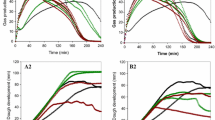Abstract
Sesame products (sesame meal, roasted and autoclaved sesame meal, sesame protein isolate and concentrate) were added to Red wheat flour to produce blends at protein levels of 14, 16, 18 and 20 percent. Dough properties were studied using a Brabender Farinograph. Loaves were prepared from the various blends using the straight dough procedure and then evaluated for volume, crust and crumb colour, crumb texture, flavour and overall quality. The water absorption, development time and dough weakening were increased (p<0.05) as the protein level increased in all blends; however, dough stability decreased. Sesame products could be added to wheat flour up to 18 percent protein level (sesame protein isolate) and up to 16 percent protein level (other sesame products) without any observed detrimental effect on bread sensory properties. No significant differences (p>0.05) were recorded in loaf volume between control and breads containing sesame protein isolate (up to 18 percent protein level) and either autoclaved sesame meal or sesame protein concentrate (up to 14 percent protein level). Addition of sesame products increased the content not only of protein but also minerals and total essential amino acids, especially lysine. The addition also improved in-vitro protein digestibility.
Similar content being viewed by others
References
AACC (1983) Approved methods of the American Association of Cereal Chemists, 8th ed. St. Paul, MN: ALCC
Anjum FM, Ali A, Chaudhry NM (1991) Fatty acids, mineral composition and functional (Bread and Chapati) of high protein and high lysine barley lines. J Sci Food Agric 55: 511–519.
AOAC (1984) Official Methods of Analysis, 14th ed. Association of Official Analytical Chemists, Washington, D.C.
Bookwalter GN, Kirleis AW, Mertz ET (1987) In-vitro digestibility of protein milled sorghum and other processed cereals with and without soy fortification. J Agric Food Chem 35: 347–351.
Burns EE, Talley LJ, Brummett BJ (1972) Sunflower utilization in human foods. Cereal Sci Today 17: 287–292.
Deshpande SS, Rangnekor PD, Sathe SK, Salunkhe DK (1983) Functional properties of wheat-bean composite flours. J Food Sci 48: 1659–1663.
El-Adawy TA (1992) Chemical, technological studies and characterization of apricot kernel proteins. Ph. D. Thesis, Fact. Agric., Menofiya Univ., Shibin El-Kom, Egypt.
El-Farra AA, Ismail AA, Khourshid AM (1981) Liquid whey milk and its effect on wheat flour dough and pasta properties. Egypt J Food Sci 9: 49–57.
Faheid SM (1992) Application of sieve fractionation on wheat flours to improve different quality characteristics for bread-making. Egypt J Food Sci 20: 159–173.
FAO/WHO (1973) Energy and Protein Requirements. Report of FAO Nutritional Meeting Series No. 52, FAO, Rome.
Fogg NE, Tinkling GL (1972) Influence of glandless cottonseed flour on quality, acceptability, and amino acid content of sugar cookies. Cereal Sci Today 17: 70–75.
Gonzalez-Agramon M, Serna-Saldivar SO (1988) Effect of defatted soybean and soybean isolate fortification on the nutritional, physical, chemical and sensory properties of wheat flour tortillas. J Food Sci 53: 793–797.
Gonzalez-Galan A, Wang SH, Segarbieri VC, Moraes MAC (1991) Sensory and nutritional properties of cookies based on wheat-rice-soybean flours baked in a microwave oven. J Food Sci 56: 1699–1701.
Hansmeyer WA, Satterlee LD, Mattern PJ (1976) Characterization of products from wet fractionation of wheat bran. J Food Sci 41: 505–508.
Hidvégi M, Békés F (1984) Mathematical modeling of protein quality from amino acid composition. Proc Int. Assoc. Cereal Chem. Symp., ed. Lásztity, R. and Hidvégi, M. Akadémiai Kiadó, Budapest, p. 205.
Khan MN, Rhee KC, Rooney LW, Cater CM (1975) Bread baking properties of aqueous processed peanut protein concentrates. J Food Sci 40: 580–583.
Matthews RH, Sharpe EJ, Clark WM (1970) The use of some oilseed flours in bread. Cereal Chem 47: 181–185.
Miller EL (1967) Determination of tryptophan content in feeding stuffs with particular reference to cereal. J Sci Food Agric 18: 381–386.
Moore S, Stein WH (1963) Chromatographic determination of amino acids by the use of automatic recording equipment. In Methods in Enzymology, Vol. 6, ed. Colowick SP and Kaplan NO. Academic Press, New York, p. 860.
Morad MM, El-Magoli SB, Afifi SA (1980) Macaroni supplemented with lupine and defatted soybean flour. J Food Sci 45: 404–405.
Oser BL (1959) An integrated essential amino acid index for predicting the biological value of proteins. In Protein and Amino Acid Nutrition, ed. Albanese AA Academic Press, New York, p. 295.
Rasco BA, Hashisaka AE, Dong FM, Einstein MA (1989) Sensory evaluation of baked goods incorporating different levels of distiller's dried grains with solubles from soft white winter wheat. J Food Sci 54: 337–342.
Rasco BA, Rubenthaler G, Borhan M, Dong FM (1990) Baking properties of bread and cookies incorporating distillers or brewer's grain from wheat or barley. J Food Sci 55: 424–429.
Roony LW, Gustafson CB, Clark SP, Cater CM (1972). Comparison of the baking properties of several oilseed flours. J Food Sci 37: 15–19.
Salama NA, Abd El-Latef AR, Shouk AA, Alian AM (1992) Effect of some improvers on the nutritional components and in-vitro digestibility of Egyptian balady bread. Egypt J Food Sci 20: 135–146.
Salgó A, Granzler K, Jecsai J (1984) Simple enzymatic methods for predication of plant protein digestibility. Proc Int Assoc Cereal Chem Symp, ed. Lásztity R and Hidvégi M. Akadémiai Kiadó, Budapest, p. 321.
Steel RG, Torrie JH (1980) In ‘Principles and Procedures of Statistics’ 2nd ed, MacGraw-Hill Book Co., New York.
Talley LJ, Brummett BJ, Burns EE (1972) Sunflower food products Texas A & M Univ., The Texas Agricultural Experiment Station, MP 1026.
Taussky HH, Shorr E (1953) A microcolorimetric method for the determination of inorganic phosphorus. J Biol Chem 202: 675–679.
Yue P, Nettiarachchy N, D'Appolonia BL (1991) Native and succinylated sunflower proteins use in bread making. J Food Sci 56: 992–995.
Author information
Authors and Affiliations
Rights and permissions
About this article
Cite this article
El-Adawy, T.A. Effect of sesame seed proteins supplementation on the nutritional, physical, chemical and sensory properties of wheat flour bread. Plant Food Hum Nutr 48, 311–326 (1995). https://doi.org/10.1007/BF01088490
Received:
Accepted:
Issue Date:
DOI: https://doi.org/10.1007/BF01088490




